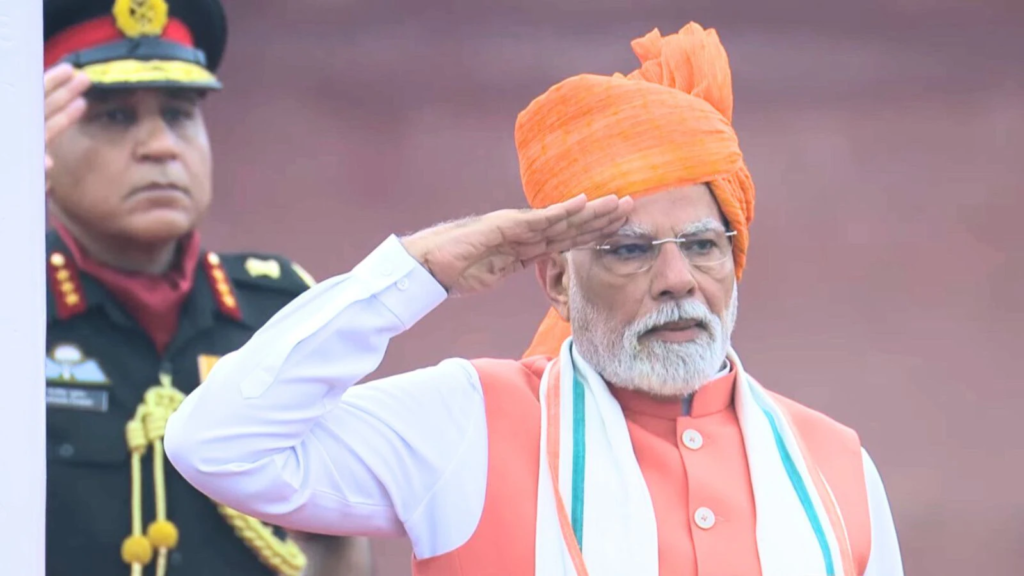| UPSC Relevance GS Paper I: Society, culture, citizen participation, Swadeshi adoption. GS Paper II: Internal & border security, demographic threats, governance, policy initiatives. GS Paper III: Economy (GST reforms, employment schemes, MSMEs), Science & Technology (AI, semiconductors, cybersecurity), Energy (renewables, nuclear, critical minerals), Agriculture & Food Security, Defence technology. |
Why in News?
On India’s 79th Independence Day, Prime Minister Narendra Modi delivered his longest-ever Independence Day speech, spanning 103 minutes, from the Red Fort. The address emphasized Atmanirbhar Bharat (self-reliance) as a foundation for a Viksit Bharat (Developed India) by 2047, outlining policies and initiatives in defence, economy, technology, energy, agriculture, manufacturing, and national security.

Background
Since 2014, PM Modi has consistently stressed self-reliance as a growth model extending beyond economic independence to include defence, technology, energy, and socio-cultural resilience.
- Example: Operation Sindoor (2025) – Indian forces successfully conducted deep strikes in Pahalgam using indigenous arms, showing the link between self-reliance and national security.
- Economic rationale: Reducing import dependency in semiconductors, critical minerals, and energy strengthens strategic and economic autonomy.
- Cultural dimension: Promoting Swadeshi goods and campaigns like “Vocal for Local” encourages citizen participation and national pride.
This vision aligns with India’s 2047 centenary goal, aiming to position India as a global power.
Key Highlights
1. Defence and Security
- Operation Sindoor: Indigenous arms and weapon systems were successfully used in a counter-terror operation, demonstrating operational freedom for the Army.
- Sudarshan Chakra Weapon System: Announced to be developed by 2035, aimed at creating a next-generation defence shield, similar to Israel’s Iron Dome.
- Strategic Autonomy: Emphasis on reducing defence import dependency, echoing earlier efforts like Tejas fighter aircraft development.
- High-Power Demography Mission: Focused on border areas where infiltration and demographic changes could pose security threats.
Example: PM Modi explicitly warned against “conspiracies to alter the demographic character of border regions,” showing proactive governance in sensitive areas like Ladakh and Arunachal Pradesh.
2. Economic Reforms
- Second-Generation GST Reforms: Task force formed to reduce prices of essential goods, acting as a “Diwali gift” for citizens.
- Next-Generation Reforms: High-powered task force to improve India’s global competitiveness, learning from models like South Korea and Germany.
- Pradhan Mantri Viksit Bharat Rozgar Yojana:
- Corpus: ₹1 lakh crore.
- Incentive: ₹15,000 one-time grant for first-time private sector employees, encouraging youth employment.
- MSME Relief: Lower compliance costs and legal protection, similar to reforms in stand-up India and Udyam registration.
Example: The scheme incentivizes private sector participation, like Infosys and TCS employing first-time graduates under government incentives, generating employment.
3. Technology and Innovation
- Semiconductor Mission: India to produce Made-in-India chips by 2025; currently 6 units functional, 4 approved.
- Emphasis on AI, cybersecurity, deep-tech, and indigenous operating systems.
- Example: Indigenous OS like Bharat Operating System Solutions (BOSS) is being promoted in government departments to reduce reliance on foreign software.
- Rationale: In a tech-driven 21st century, chips power AI, defence, communication, and digital governance, making semiconductor sovereignty crucial.
4. Energy and Critical Minerals
- Nuclear Energy: Plan to increase capacity tenfold by 2047 via 10 new reactors.
- Critical Minerals Mission: 1,200 exploration sites for minerals like lithium, cobalt, and rare earth elements, reducing import dependency.
- Renewable Energy Expansion:
- Solar energy increased 30-fold in the last decade.
- Hydropower expansion through new dams, e.g., Subansiri Lower Dam Project.
- Mission Green Hydrogen invested in large-scale production for industry.
Example: Reducing dependence on imported crude, urea, and rare metals strengthens energy and strategic security, similar to China’s resource-centric policies.
5. Agriculture and Farmers’ Protection
- PM Modi compared the current focus on energy and technological independence to the Green Revolution, which ensured food security.
- Commitments include:
- Protecting farmers’ interests in international trade negotiations (e.g., WTO farm subsidy discussions).
- Reducing fertilizer import dependency, as India imports ~50% of urea.
- Promoting modern agricultural practices and technology adoption.
Example: Adoption of precision farming and organic fertilizers in Punjab and Maharashtra demonstrates the alignment of policy with self-reliance.
6. Manufacturing and MSMEs
- National Manufacturing Mission: India to become a global manufacturing hub, similar to China’s export-led growth.
- MSMEs: Enhance capability to integrate into global supply chains.
- Zero Defect, Zero Effect: Policy emphasizes quality and environmental sustainability.
Example: MSMEs producing auto components for Maruti Suzuki and Tata Motors benefit from capacity-building and compliance relief.
7. Socio-Cultural and Political Messaging
- RSS Recognition: Nearing centenary, termed “world’s largest NGO”.
- Citizen campaigns: “Vocal for Local” to promote Swadeshi goods.
- Longest I-Day speech: Symbolizes strong leadership and governance confidence.
Example: Swadeshi adoption in local markets, like handloom clusters in Varanasi and Bhagalpur, aligns citizens with national self-reliance goals.
Key Challenges Highlighted
- Border and Demographic Threats: Infiltration and demographic shifts in sensitive areas.
- Technological Lag: Catching up in semiconductors, AI, and deep-tech sectors.
- Import Dependence: Energy, critical minerals, and fertilizers.
- Quality and Productivity Gaps: In manufacturing and MSMEs.
Way Forward
- Strengthen R&D in defence, energy, and technology.
- Promote inclusive growth, integrating farmers, MSMEs, and youth.
- Ensure border and demographic security through governance, development, and surveillance.
- Encourage Swadeshi adoption and citizen participation.
- Balance self-reliance with global cooperation.
Conclusion
PM Modi’s 2025 Independence Day speech frames Atmanirbharta as both an economic necessity and a national ethos. From Operation Sindoor to semiconductors, energy transition to manufacturing, the speech outlines a roadmap for India to emerge as a confident, secure, and developed nation by 2047.
UPSC Practice Questions
1. Which of the following statements are correct about the Pradhan Mantri Viksit Bharat Rozgar Yojana (PMVBRY)?
- The government has allocated a corpus of ₹1 lakh crore for the scheme.
- First-time private sector employees will receive a one-time incentive of ₹15,000.
- The scheme exclusively supports self-employment for existing businesses.
A. 1 and 2 only
B. 1 only
C. 3 only
D. All of the above
Answer: A
Mains-Q. “Self-reliance is the cornerstone of India’s vision for Viksit Bharat 2047.” Examine this statement in the context of PM Modi’s Independence Day 2025 speech, with reference to economic, security, and technological dimensions.(250 words,15 marks)
SOURCE- THE HINDU
Found this helpful?
Bookmark for revision, Practice the mains question, and
Share with fellow aspirants! THANK YOU
